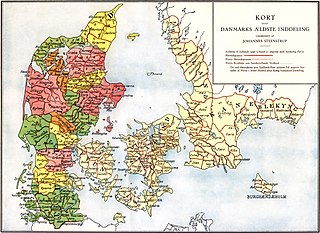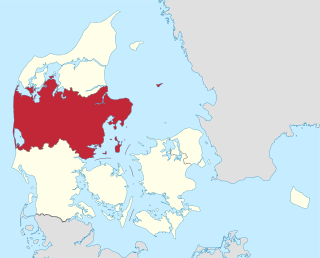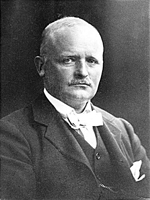This is list of archives in Denmark.
This is list of archives in Denmark.
The following archives have since been integrated into the Danish National Archives:

Tourism in Denmark is a growing industry and a major economic contributor: tourists spent a total of DKK 128 billion and the tourism industry employed 161,999 people in full time positions in 2017.

The three lands of Denmark historically formed the Danish kingdom from its unification and consolidation in the 10th century:

The Central Denmark Region, or more directly translated as the Central Jutland Region and sometimes simply Mid Jutland, is an administrative region of Denmark established on 1 January 2007 as part of the 2007 Danish municipal reform. The reform abolished the traditional counties (amter) and replaced them with five new administrative regions. At the same time, smaller municipalities were merged into larger units, cutting the total number of municipalities from 271 to 98. The reform diminished the power of the regional level dramatically in favour of the local level and the national government in Copenhagen. The Central Denmark Region comprises 19 municipalities.

The North Jutland Region, or in some official sources, the North Denmark Region, is an administrative region of Denmark established on 1 January 2007 as part of the 2007 Danish municipal reform, which abolished the traditional counties and set up five larger regions. At the same time, smaller municipalities were merged into larger units, cutting the number of municipalities from 271 before 1 January 2006, when Ærø Municipality was created, to 98. North Jutland Region has 11 municipalities. The reform diminished the power of the regional level dramatically in favor of the local level and the central government in Copenhagen.

Hack Kampmann was a Danish architect, Royal Inspector of Listed State Buildings in Jutland and professor at the architecture department of the Royal Danish Academy of Fine Arts. Marselisborg Palace in Aarhus, built between 1899 and 1902, is among his best known works.

The Aarhus Theatre in Aarhus, is the largest provincial theatre in Denmark.

Southern Jutland is the name for the region south of the Kongeå in Jutland, Denmark and north of the Eider (river) in Schleswig-Holstein, Germany. The region north of the Kongeå is called Nørrejylland, 'Northern Jutland'. Both territories had their own ting assemblies in the Middle Ages. Southern Jutland is mentioned for the first time in the Knýtlinga saga.

Aalborg Historical Museum is a historical and cultural museum in the city of Aalborg in Denmark. The museum was established in 1863 and is now part of The Historical Museum of Northern Jutland.

The Danish National Archives is the national archive system of Denmark. Its primary purpose is to collect, preserve and archive historically valuable records from central authorities, such as ministries, agencies and national organisations and make them available to the public. The archive is part of the Ministry of Culture.

Jutland Art Academy, is a state recognized institute for higher education in Aarhus, Denmark, offering a 5-year programme in contemporary art. The academy has no departments and focuses on conceptually driven practices and transdisciplinary work. The academy has about 50 students. The school is located in the street of Mejlgade in the Latin Quarter of Aarhus.
The 1912–13 Danish National Football Tournament was the first Danish championship under the Danish Football Association.
The 1914–15 Danish National Football Tournament was supposed to have been the third Danish football championship, but was cancelled since World War I made travelling greater distances difficult. The regional championships were still held, however.

Jutland, known anciently as the Cimbric or Cimbrian Peninsula, is a peninsula of Northern Europe that forms the continental portion of Denmark and part of northern Germany. The names are derived from the Jutes and the Cimbri, respectively.

Danish national cycle route 5, known as the Østkystruten, is the fifth of the 11 Danish National Cycle Routes. It runs from Sønderborg in Southern Jutland to Skagen, the northernmost tip of Jutland in the Northern Jutland region. It follows the east coast of Jutland and is 650 km (400 mi) long, with 90% of this distance being along paved roads.

The Danish National Exhibition of 1909 or The National Exhibition in Aarhus 1909 was an industry, crafts and culture exhibition held in Aarhus, Denmark in 1909 from 18 May to 3 October. The exhibition displayed some 1850 individual works by architects, artists, craftsmen and businesses and attracted 650.000 visitors. The project was a large undertaking for the city with long-lasting effects on cultural institutions and short-term economic problems. The exhibition fairgrounds was named The white City based on the architectural expression chosen by the leading architect Anton Rosen.

Ottine Caroline Emilie Andersen (1895–1970) was a Danish historian and archivist. An intricate researcher, her first published work Grams Historie (1926) was a detailed history of the Gram Estate at Gram in the south of Jutland which she undertook for its owner Adolph Brockenhuus Schack. After working for the Provincial Archives of Southern Jutland and then those of Zealand, in 1958 she was engaged by the National Archives where she developed a legendary competence in documenting historical records, in particular the archives of Christian II, integrating sources from Stockholm and Oslo. The corresponding registry titled München-Samlingen was published in 1969 as Volume 15 of Vejledende Arkivregistraturer.